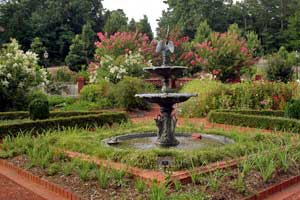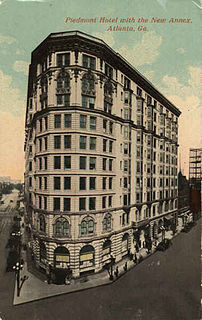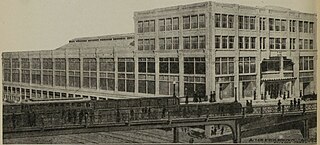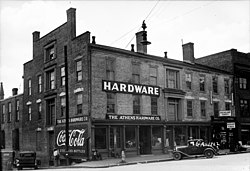
Athens, officially Athens–Clarke County, is a consolidated city–county and college town in the U.S. state of Georgia. Athens lies about 70 miles northeast of downtown Atlanta, and is a satellite city of the capital. The University of Georgia, the state's flagship public university and an R1 research institution, is in Athens and contributed to its initial growth. In 1991, after a vote the preceding year, the original City of Athens abandoned its charter to form a unified government with Clarke County, referred to jointly as Athens–Clarke County.

The State Botanical Garden of Georgia is a botanical garden of 313 acres in the United States, with a conservatory operated by the University of Georgia. It is located at 2450 South Milledge Avenue, Athens, Georgia.

Thomas Reade Rootes Cobb was an American lawyer, author, politician, and Confederate States Army officer, killed in the Battle of Fredericksburg during the American Civil War. He was the brother of noted Confederate statesman Howell Cobb.
Augustin Smith Clayton was a jurist and politician from the American state of Georgia.

Charles Holmes Herty Sr. was an American academic, scientist, and businessman. Serving in academia as a chemistry professor to begin his career, Herty concurrently promoted collegiate athletics including creating the first varsity football team at the University of Georgia. His academic research gravitated towards applied chemistry where he revolutionized the turpentine industry in the United States. While serving as the president of the American Chemical Society, Herty became a national advocate for the nascent American chemical industry and left academia to preside over the Synthetic Organic Chemical Manufacturers' Association (SOCMA) and the Chemical Foundation. He was also instrumental in the creation of the National Institutes of Health. Towards the end of his career, Herty's research and advocacy led to the creation of a new pulp industry in the Southern United States that utilized southern pine trees to create newsprint.
John Noland was an enslaved man who was the personal servant of bushwhacker William C. Quantrill during the American Civil War. Noland was a chattel slave owned by Francis Asbury Noland in Jackson County, Missouri.
Normaltown is a neighborhood in Athens, Georgia, by the Athens Regional Medical Center and named for the State Normal School formerly located there. It was the first area of Athens to be wired for electricity after the completion of the Mitchell Bridge hydroelectric plant in 1896.

The Downtown Athens Historic District is a historic area in the Downtown Athens neighborhood of Athens, Georgia. It was listed on the National Register of Historic Places in 1978. Its boundaries were revised twice, in 1984 and 2006, and additional documentation was filed in 2006.

The Lucy Cobb Institute was a girls' school on Milledge Avenue in Athens, Georgia, United States. It was founded by Thomas R.R. Cobb, and named in honor of his daughter, who had died of scarlet fever at age 14, shortly before construction was completed and doors opened; it was incorporated in 1859. The cornerstone for the Seney-Stovall Chapel was laid in May 1882, and the octagonal building was dedicated in 1885. The school closed in 1931.

Mildred Lewis "Miss Millie" Rutherford was a prominent white supremacist educator and author from Athens, Georgia. She served the Lucy Cobb Institute, as its head and in other capacities, for over forty years, and oversaw the addition of the Seney-Stovall Chapel to the school. Heavily involved in many organizations, she became the historian general of the United Daughters of the Confederacy (UDC), and a speech given for the UDC was the first by a woman to be recorded in the Congressional Record. She was a prolific non-fiction writer. Also known for her oratory, Rutherford was distinctive in dressing as a southern belle for her speeches. She held strong pro-Confederacy, proslavery views and opposed women's suffrage.

The Henry Grady Hotel was a hotel in downtown Atlanta, Georgia, United States. The building, designed by architect G. Lloyd Preacher, was completed in 1924 at the intersection of Peachtree Street and Cain Street, on land owned by the government of Georgia that had previously been occupied by the official residence of the governor. The hotel, which was named after journalist Henry W. Grady, was owned by the state and leased to operators. During the mid-1900s, the hotel typically served as the residence of state legislators during the legislative sessions, and it was an important location for politicking, with President Jimmy Carter later saying, "[m]ore of the state's business was probably conducted in the Henry Grady than in the state capitol". In the late 1960s, the government decided to not renew the building's lease when it expired in 1972, and it was demolished that year. The land was sold to developers and the Peachtree Plaza Hotel was built on the site. At the time of its completion in 1976, it was the tallest hotel building in the world.

Camak House, at 279 Meigs Street, Athens, Georgia, was built in about 1834 by James Camak and featured in Georgia's early railroad history. An example of Federal architecture, it has a number of features unusual for its period, including a kitchen within the raised basement, and closets. Both main floors have four rooms; the stairwell has a mahogany railing, and moldings and trim were made using a Greek key pattern. After long service as a family home, it was used as a Masonic Lodge before being bought by Coca-Cola Enterprises. In 1975 Camak House was listed on the National Register of Historic Places, but the building had by then fallen into disrepair. It was restored and used as the offices of a law firm. As of December 2011, it is for sale.

The Piedmont Hotel was a hotel which took up the block between Peachtree, Luckie, Forsyth and Broad streets in Atlanta, Georgia. The hotel opened with a gala celebration on January 15, 1903. It was built on the site of the homesteads of Atlanta pioneers William Ezzard and Dr. James F. Alexander]. It was Atlanta's first "New York" or Northern-style hotel. It entertained Presidents Theodore Roosevelt and Woodrow Wilson, and Presidential candidate William Jennings Bryan. It was the favorite hotel of visiting opera stars until the opening of the Georgian Terrace in Midtown.
Washington Hall was a historic hotel in antebellum Atlanta, Georgia. Built in 1846, the building was one of the earliest hotels built in the city. The hotel, along with many other structures in the city, was destroyed in 1864 during the Battle of Atlanta.

The Ware–Lyndon House is a historic house located at 211 Hoyt Street in Athens, Georgia, at the end of Jackson Street. Built circa 1850, the house is two stories and exhibits an Italianate style. Edward R. Ware, its original owner, sold the property to Edward S. Lyndon in 1880. In 1939, the city of Athens purchased the home and a major restoration was made in 1960. In 1976, it was placed on the National Register of Historic Places. It is the only surviving structure from the Lickskillet neighborhood of Athens, one of the most fashionable districts of its time.

The Peachtree Arcade was a shopping arcade in downtown Atlanta, Georgia, United States. The building, modeled after the Arcade in Cleveland, was designed by Atlanta-based architect A. Ten Eyck Brown and was located between Peachtree Street and Broad Street near Five Points. Construction began in 1917 and was completed the following year. Located in the city's central business district, it was very popular with citizens, functioning as an unofficial "civic center" for the city. However, by the 1960s, the arcade was facing increased competition from shopping malls located in Atlanta's suburbs, and in 1964, the building was demolished to make way for the First National Bank Building, a skyscraper that, at the time of its construction, was the tallest building in both Atlanta and the southeastern United States. In 1993, the American Institute of Architects named the building as one of Atlanta's most notable landmarks to have been destroyed.

The Joseph Henry Lumpkin House was built in the 1830s, and purchased by its namesake, the first chief justice of the Georgia Supreme Court, in 1842.
Bludwine, later Budwine, was a brand of cherry-flavored soft drink and flavored syrups that was originally produced in the United States by the Bludwine Company and Bludwine Bottling Company. The Bludwine Company was founded by Henry C. Anderson in spring, 1906. Bludwine Company produced the master elixir in Athens, Georgia, and various Bludwine Bottling Company locations processed the elixir into syrup and bottled soft drinks prepared from the syrup. The syrups were also shipped to and used at soda fountains as an ingredient to add flavor to various beverages. In 1911 Bludwine was marketed as having health benefits, such as aiding in digestion, and some physicians in Athens, Georgia and other areas of the state prescribed it to their patients. The brand's name was changed from Bludwine to Budwine in 1921. Production of Budwine stopped in the mid 1990s.

Hill First Baptist Church "is the oldest African American church in the Athens, Georgia community". It is a contributing property to the Reese Street Historic District.

William Winstead Thomas (1848–1904) was an American insurance company president and an architect.


















